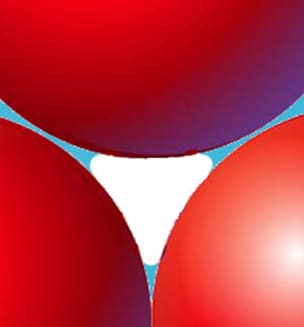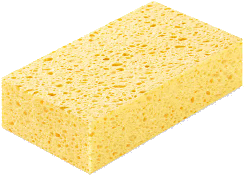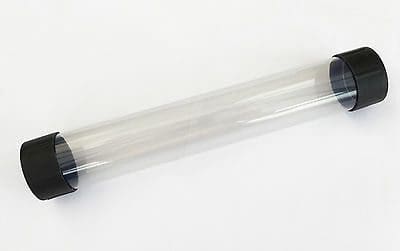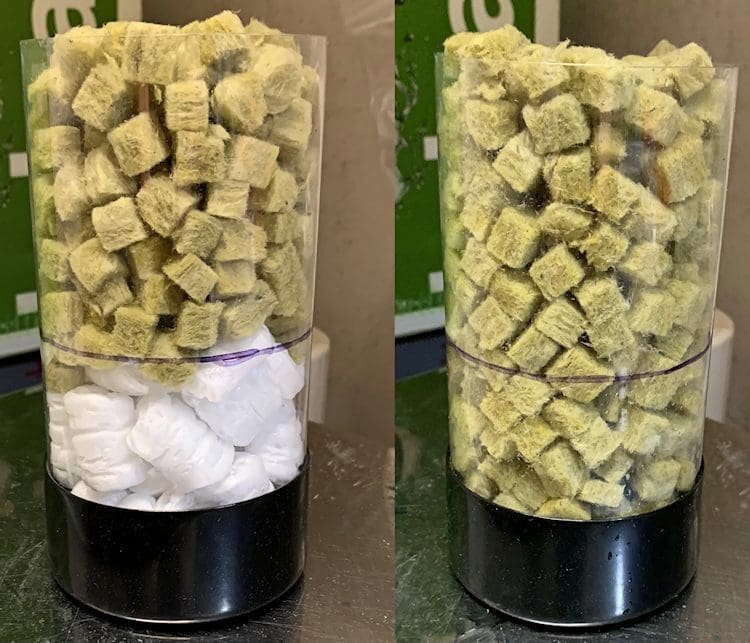
Any experienced orchid grower knows that they key to success is mastering the balance between water and air in the potting medium – keeping the potting medium airy while providing copious moisture to the plant. Let’s first take a look at how a potting medium holds onto moisture.
When we water, most of the solution simply pours right through the medium; some is immediately absorbed by the plant’s roots and the potting medium components, but there is a third fraction – that “bridges” the particles, held in place by surface tension, overcoming the force of gravity that is trying to let it drain. It is that fraction that’s important, because if all the voids are filled with bridging water, the roots will suffocate.

“Surface tension” is limited in its ability to hold the water in place, which is why the use of a “coarse” potting medium with large particles – hence large voids between them – will be airier than a fine mix. Another one of the ways that is often suggested to enhance airiness is to add a “drainage layer” of crockery or foam packing peanuts to the bottom of the pot. Unfortunately, surface energy comes into play a bit counter-intuitively in that case.
In a container, the bottom of the column of potting medium is supporting the weight of the material above it. The mostly-rigid potting media components are merely held in place by gravity, but the bridging water can move and exert pressure downward, so the weight of the water column, when added to the force of gravity, may overcome the holding ability of surface tension, resulting in better drainage.
I got the idea about this when doing some dishes, and this is something you can easily try for yourself with an ordinary sponge.

Submerge the sponge in water and squeeze it enough to full saturate it, then carefully, without squeezing it, lift it out of the water in a flat orientation, letting the excess water drain (I did this in a large, flat-bottomed sieve). When it has finished draining, carefully stand it on an edge – you’ll see even more water drain from the sponge! Based upon that, I decided to try an experiment to see if that applied to potted plants.
For a container, I used a 3″ diameter plastic document storage tube, which I cut to be 6″ tall. I placed a mark at 3″ and cut a hole in the end-cap for drainage.

I used Grodan Mini-Cubes as the potting medium and ordinary expanded polystyrene “packing peanuts” as my “drainage layer”.

I weighed the Grodan cubes to give me “full” and “half” amounts, and after putting each inch of cubes in the cylinder, I added standard compression by setting a full can of spray paint on it before adding the next inch of material. They were then taken to the kitchen sink, where I was able to rapidly fill each “pot”, then let it full drain. Here’s the data:
FULL | HALF | |
Diameter (cm) | 7.62 | 7.62 |
Height (cm) | 15.24 | 7.62 |
Volume (cc) | 695.0 | 347.5 |
Continer Weight (g) | 68 | 68 |
Peanuts (g) | 0 | 2 |
Grodan (g) | 36 | 18 |
Density (g/cc) | 0.52 | 0.52 |
Dry Total Weight (g) | 104 | 88 |
Wet Total Weight (g) | 438 | 299 |
Weight of Water (g) | 334 | 211 |
Looking at the bottom line of data – if the water-holding capacity was independent of height, we would expect the “Half” sample to contain half of the water held in the full sample – 334/2=167 grams – but in fact, it held 211 grams of water, more than 25% more. There were also 5 grams of water held by the foam peanuts, so I deducted that from the wet weight of the Grodan.
There is no question that a “drainage” layer, by essentially making the drainage “hole” the same diameter as the pot, will help the in pot drain more quickly, but it also increases the percentage of bridging water in the medium, so if you’re trying to make the potting medium more airy for the plant, using a coarser medium if far better than adding a drainage layer to the bottom of the pot.
